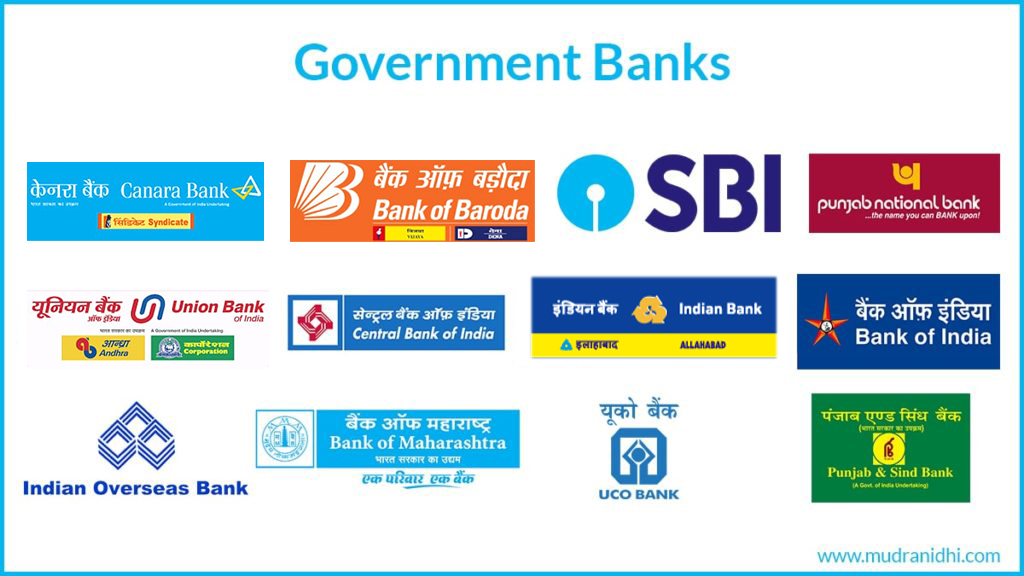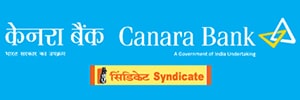Find the updated list of Government banks in India after the merger of banks below.
Public Sector Banks or Government banks are the banks having major capital shareholding (>=51%) from Government. There are a total of 12 Government banks in India left after the merger of 10 public sector banks.
Table of Contents
List of Government Banks in India 2024

Previously there were 18 Nationalised banks in India but recently in a mega-merger, 10 banks were merged and the count came down to 12. The following are the Nationalised in India:
- BANK OF BARODA
- BANK OF INDIA
- BANK OF MAHARASHTRA
- CANARA BANK
- CENTRAL BANK OF INDIA
- INDIAN BANK
- INDIAN OVERSEAS BANK
- PUNJAB AND SIND BANK
- PUNJAB NATIONAL BANK
- STATE BANK OF INDIA
- UCO BANK
- UNION BANK OF INDIA
Let’s have a look at each bank with a little introduction to them.
Bank of Baroda

The Maharaja of Baroda, Maharaja Sayajirao Gaekwad III founded the Bank of Baroda on 20th July 1908. The bank was later nationalized on 19th July 1969 and is at present considered the second largest bank of India. The bank has won many laurels in its more than 100 years of history including Best Bank (Public Sector) in 2014. In 2017, the Bank of Baroda became the first National Supporter (Indian sponsor) of the FIFA U-17 World Cup, the first football World Cup to be hosted in India. According to a 2019 report, the bank is ranked 1145 on the Forbes Global 2000 list. In 2019, BOB had Vijaya Bank and Dena Bank merged into it.
Head office: Vadodara, Gujarat
Branches: 9000+
Total Asset: ₹1,525,878.97 crore (US$190 billion)
Number of employees: 85000+
Customer care no. 18002584455/18001024455
Government stake: 69.2%
Official Website: www.bankofbaroda.in
Bank of India

A group of Mumbai’s eminent businessmen founded the Bank of India on 7th September 1906 as a private venture which was later nationalized in 1969 along with a few other banks. The Bank of India has 5000+ branches all over India which are controlled by 54 Zonal Offices and 8 NBG Offices. The bank is among the top five Indian banks and is a founder member of SWIFT (Society for Worldwide Inter Bank Financial Telecommunications), which enables the delivery of cost-effective fiscal processing and communication services.
Head office: Mumbai, Maharashtra
Branches: 5000+
Total asset: ₹725,856.45 crores (US$91 billion)
Number of employees: 48000+
Customer care no. 1800 103 1906 / 1800 220 229 / 022 – 40919191
Official Website: www.bankofindia.co.in
Bank of Maharashtra

Mr V. G. Kale and D. K. Sathe established the Bank of Maharashtra on 16th September 1935 at Pune, Maharashtra. The bank is currently the leading bank of Maharashtra with the largest network of branches by any public sector bank in the state. Bank of Maharashtra has four zonal offices in Vidarbha i.e Nagpur, Amravati, Chandrapur, and Akola. The bank acquired an autonomous status in the year 1998 and consequently has the limited intervention of Government bureaucracy in its decision-making process and internal affairs.
Head office: Pune, Maharashtra
Branches: 1900+
Total Asset: ₹184,082 crores (US$23 billion)
Number of employees: 12,000+
Customer care no. 1800 233 4526
Government stake: 87.74%
Official Website: www.bankofmaharashtra.in
Canara Bank

Mr. Ammembal Subba Rao Pai founded the Canara Bank in 1906 in the city of Mangalore as a private sector bank which was later turned into a public sector enterprise in the year 1969. Under the leadership of Mr. Rao Pai, the bank was initially named Canara Permanent Hindu Fund, and later the name was changed to Canara Bank Limited in 1910. At present, the bank has a network of 6310 branches and 8851+ ATMs spread across 4467 centers. The bank also has offices abroad in London, Hong Kong, Moscow, Shanghai, Dubai, Tanzania and New York.
Syndicate Bank bank was merged into Canara bank. For Syndicate Bank and the Canara Bank merger, the share swap ratio will be 158 equity shares of Canara Bank for every 1,000 equity shares of Syndicate Bank.
Head office: Bangalore, Karanataka
Branches: 6000+
Total Asset: ₹1,381,029.56 crore (US$170 billion)
Number of employees: 1,00,000+
Customer care no. 1800 425 0018
Government stake: 70.62%
Official Website: www.canarabank.com
Central Bank of India

Sir Sorabji Pochkhanawala along with Sir Pherozeshah Mehta established the Central Bank of India on 21st December 1911. The bank has pioneered many achievements in its over a hundred years of history. In 1921, the bank introduced the Home Savings Safe Deposit Scheme to encourage saving habits in all sections of society. In 1921, it founded an All Exclusive Ladies Department to cater to its female clients. Apart from its regular services, the Central Bank of India also plays an important role in promoting the key thrust areas in agriculture, and small scale industries.
Head office: Mumbai, Maharashtra
Branches: 4681
Total Asset: ₹369,214.99 crores (US$46 billion)
Number of employees: 37,162 (2018)
Customer care no. 1800 22 1911
Official Website: www.centralbankofindia.co.in
Indian Bank

The Indian Bank was established on 15th August 1907 as a part of the Swadeshi Movement. The bank has a Pan India presence with 9786 touch points consisting of 2872 domestic branches, 3892 ATMs, and 3022 BCS. All the branches of this bank operate under Core Banking Solution. The Indian Bank network comprises 277 overseas correspondent banks in 75 nations. The bank has two subsidiary companies- Ind Bank Housing Limited and Indbank Merchant Banking Services Limited. The bank has bagged numerous awards including the “Makers of Excellence Leadership Award” from PFRDA in the fiscal year 2017-18. Allahabad Bank merged with Indian Bank.
Head office: Chennai, Tamil Nadu
Branches: 3000+
Total Asset: ₹710,500.73 crore (US$89 billion)
Number of employees: 20,000+
Customer care no. 1800 425 00 000 / 1800 425 4422
Official Website: www.indianbank.in
Indian Overseas Bank

Shri M. Ct. M. Chidambaram Chettiar founded the Indian Overseas Bank (IOB) on 10th February 1937 with the objective of specializing in foreign exchange business in banking. The bank established its simultaneous branches at Karaikudi, Chennai, and Rangoon in Burma followed by a branch in Penang, Malaysia. At present, IOB has its overseas presence in 5 countries- Singapore, Hong Kong, Thailand, Sri Lanka, and South Korea. The bank is sponsoring two Regional Rural Banks- Pandiyan Grama Bank in Tamil Nadu and Odisha Gramya Bank in Odisha. The bank has received many accolades including the IBA Award for best use of data in the financial year 2015-16.
Head office: Chennai, Tamil Nadu
Branches: 3000+
Total Asset: ₹274,000.35 crore (US$34 billion)
Number of employees: 30,0000+
Customer care no. 1800 425 4422
Official Website: www.iob.in
Punjab and Sind Bank

Bhai Vir Singh, Sir Sunder Singh Majitha, and Sardar Tarlochan Singh together established the Punjab and Sind Bank in the year 1908. The bank has its headquarters in New Delhi and has its largest network in the state of Punjab and out of its 1559 branches spread throughout India, 623 branches are in Punjab state alone. Punjab and Sind Bank was founded on the principle of the social pledge to assist the weaker section of the society in their fiscal undertakings to raise their standard of living. On 15th April 1980, Punjab & Sind Bank was nationalized along with six other banks in the second wave of nationalizations.
Head office: Rajendra Place, New Delhi
Branches: 1500+
Total Asset: ₹121,067.55 crore (US$15 billion)
Number of employees: 10,000+
Customer care no. 1800 419 8300
Official Website: www.psbindia.com
Punjab National Bank

Shri Dyal Singh Majithia and Lala Lajpat Rai established the Punjab National Bank (PNB) in 1894 in Lahore, in present-day Pakistan. The bank has its current headquarters in New Delhi, India and consists of 7001 branches and 10681 ATMs across 764 cities. The bank has the honour of being the first Indian bank to have been started entirely with Indian funds that have continued to the present day. With over a hundred years of inception, the PNB has won many laurels such as the award for the ‘Best Public Sector Bank’ by CNBC TV18 in 2012.
PNB has two more banks Oriental Bank of Commerce and United Bank of India merged into it. As per recent merger development, according to regulatory filings, for every 1,000 shares, OBC bank shareholders and United Bank of India shareholders will get 1,150 shares and 121 shared of PNB respectively.
Head office: Delhi
Branches: 11000+
Total Asset: ₹95,379 crore (US$12 billion)
Number of employees: 1,00,000+
Customer care no. 1800 180 2222, 1800 103 2222
Official Website: www.pnbindia.in
State Bank of India

The State Bank of India is a multinational banking and financial services statutory body with its headquarters in Mumbai, Maharashtra. The Bank is actively involved since 1973 in non-profit activity called Community Services Banking and its entire branches and administrative offices throughout the nation sponsor and partakes in a large number of welfare activities and social causes. The SBI has been given many laurels with the latest being the “Best Transaction Bank & Best Payment Bank in India” Award for 2019.
Head office: Mumbai, Maharashtra
Branches: 22000+
Total Asset: ₹300,972 crore (US$38 billion)
Number of employees: 250,000+
Customer care no. 1800 11 2211 / 1800 425 3800
Official Website: www.onlinesbi.com
UCO Bank

Ghanshyam Das Birla founded the United Commercial Bank (now UCO Bank) in 1943 in Kolkata with simultaneous 14 branches across different corners of India. The bank was nationalized in 1969 and the name change from United Commercial Bank to UCO Bank transpired in 1985 to avoid any international level banking confusion due to the existence of a Bangladeshi bank with the same name. The Bank’s Regional presence includes 3,078 branches and 2564 ATMs. UCO Bank presently has four overseas branches in two important international financial centres in Singapore and Hong Kong.
Head office: Kolkata, West Bengal
Branches: 4000+
Total Asset: ₹253,336.1092 crore (US$32 billion)
Number of employees: 24,000+
Customer care no. 1800 274 0123
Official Website: www.ucobank.com
Union Bank of India

Union Bank of India was established on 11th November 1919 with its headquarters in the city of Mumbai as a limited company. The bank was later nationalized in 1969. The Bank has played an extremely proactive role in the Indian economic growth and extends credit for the requirements of different economic sectors like industries, exports, trading, agriculture, infrastructure, and the individual segments to earn from a well-diversified portfolio of assets. The bank has been the proud recipient of many awards and commendations such as the “Best Financial Inclusion Initiatives” Award from IBA in 2017.
Andhra Bank and Corporation Bank merged into Union Bank. As per the board of directors meeting on 5th March 2020, the share exchange ratio will be 325 equity shares of Union Bank of India for every 1,000 equity shares in Andhra Bank and 330 shares in Union Bank for India for every 1,000 equity shares in Corporation Bank.
Head office: Mumbai, Maharashtra
Branches: 4200+
Total Asset: ₹1,288,357.10 crore (US$160 billion)
Number of employees: 36,000+
Customer care no. 1800 22 22 44
Official Website: www.unionbankofindia.co.in
Nationalized Banks Merger List
The following are the list of old banks that are merged with the new banks-
| Old Public Sector Banks | Merged with new Public Sector banks | New Name of the Public Sector Bank |
| Vijaya Bank Dena Bank | Bank Of Baroda | Bank Of Baroda |
| Syndicate Bank | Canara Bank | Canara Bank |
| Allahabad Bank | Indian Bank | Indian Bank |
| Oriental Bank of Commerce United Bank of India | Punjab National Bank | Punjab National Bank |
| State Bank of Bikaner & Jaipur State Bank of Hyderabad State Bank of Indore State Bank of Mysore State Bank of Patiala State Bank of Saurashtra State Bank of Travancore Bhartiya Mahila Bank | State Bank Of India | State Bank of India |
| Andhra Bank Corporation Bank | Union Bank Of India | Union Bank of India |
Nationalized Banks in India (What’s New)
There are 12 nationalized banks that are owned by Government. Historically, there were 20 banks in India that were nationalized in 1969 and 1980. but, with an increasingly liberalized economy and adoption of privatization, the number of nationalized banks have significantly decreased over the years.
Most of these banks were merged together to form a single bank which gave these banks more capital and operational ability. During the budget announcement 2021-2022, Union Finance Minister, Smt. Nirmala Sitaraman announced the privatisation of two public sector banks (PSBs) as part of a disinvestment drive to garner ₹1.75 lakh crore. This move by the Government would reduce the number of nationalized banks in India. There are no official comments on which bank will be merged by the Finance Ministry.
FAQ on Nationalised Banks in India
The old bank customer’s account will also be merged with the new bank. In some banks the account number will remain the same only IFSC Codes are changed but, in some banks, you’ll also get a new bank account number with new cards. Also, some terms and policy updates are also made. If your bank is merged then you can contact your branch office to inquire about your account and whether the bank has changed your account number or not.
After the bank merger, seven large public sector banks (PSBs), and five smaller banks are left which makes it a total of 12 nationalized banks left after the merger as of 2022.
Government banks are those banks where the Government holds the majority of shares (above 51%).
The advantage of banking with a Public Sector Bank in India is the stability and backing of the government when it comes to your deposit. The Public Sector Banks will not fail and not put your money at risk, it is completely risk-free because of the backing of the government.
I’m Shiv Kumar, a graduate with a passion for finance, marketing, and technology. My journey into finance started with a desire to understand money management and investing.
Our main goal is to empower individuals through financial education. We believe that everyone should have the opportunity to build a strong financial foundation. Whether you’re a seasoned investor or just getting started, we provide articles, guides, and resources to help you navigate the financial landscape.
I invite you to join our community of financially savvy individuals. Feel free to ask questions, engage with our content, and explore the topics that matter to you. Together, let’s take control of our financial futures.




